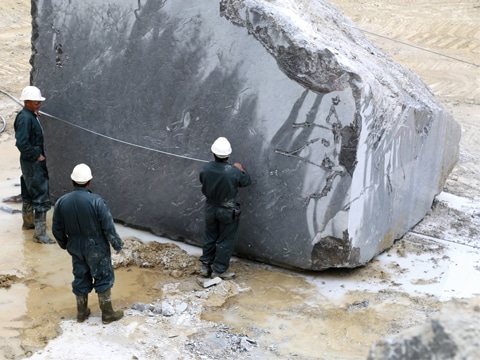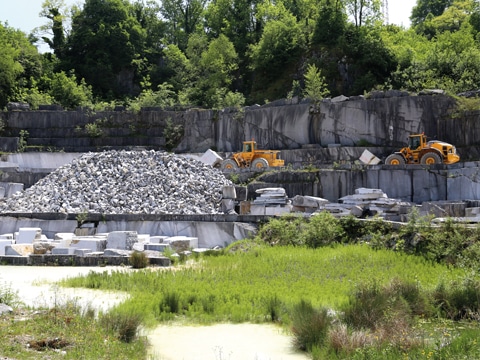A pair of L220 wheel loaders from Volvo Construction Equipment are trusted with the delicate task of transporting huge blocks of marble in the French Pyrenees.
During a recent trip to London, Joseph Laplace was able to identify the marble decorating the facades of boutiques in Piccadilly as coming from the Arudy quarries in the French Pyrenees, where his family has mined for generations.
The Tokyo showroom of fashion colossus Hermes boasts marble from Arudy, as do the Dutch Council of State building in The Hague and the entrance hall to the Mandarin Hotel in Paris. It adorns the columns of the Place de la Concorde, the French capital’s largest public square. Closer to home, Arudy marble also graces altars at the shrine of Lourdes, a major Catholic pilgrimage site since the mid-19th century, visited by millions of people every year.
These are just a few of the many destinations for marble originating from Arudy, its quality having long boosted the reputation of both the region and of France across the world.
Everlasting
An exceedingly dense and shatterproof material, marble resists frost and can last for thousands of years.
The three Laplace quarries – Sainte-Anne, Henri IV and Paloma – are renowned for their grey marble, currently in both fashion and demand. The color and patterns of the marble cut from each quarry are distinctive, of different shades to each other and with distinguishing markings.
Built on stone
Nestled against the Pyrenees, the marble quarries of Arudy were opened in the 1800s and once provided employment for hundreds of people. In the 1950s, there were still 20 active quarries, but the industry has slowly declined over the years. Laplace, along with his son Pierre and a workforce of nine, each with their own specialty, is one of the few still excavating these deposits of natural stone.
Pierre Laplace, 27, the fourth generation of his family to go into the business, handed down from father to son, explains that choosing the raw material is an artisanal skill and needs a good eye, which comes from experience.
The stone is extracted from the quarry in three stages – first cut horizontally with a diamond wire saw that makes the most of any natural fault lines, so that as little as possible of the material is lost. The second stage involves cutting the marble vertically, leaving a giant cube of stone. This slab is washed and smaller blocks of different shapes and sizes are cut according to color and direction of the grain.
The Laplace family bought their first wheel loader, a Volvo L220D, in 1999. Michel Hawryliszyn of the local Volvo dealership Van de Velde says that its aftersales service and advice on how to get the best out of the machine led to the family’s decision to invest in a second Volvo wheel loader, an L220H, which arrived in 2014.
“The type of work they do is very demanding,” says Hawryliszyn.
The wheel loaders transport huge blocks of marble from the quarries to a storage area; from here the blocks are loaded on trucks to be taken to their next destination. The wheel loaders are also used to tidy the quarries and keep them clear of debris.
Pierre Laplace says they opted for Volvo again because the machines suit the specialist aspect of their work. Thanks to the machine’s high lifting capacity and parallel lift arm, the blocks are always positioned horizontally, which significantly increases safety during transport. The machine’s compact proportions work to advantage in the confines of the quarries. Low fuel consumption was also taken into consideration.
A machine operator himself, he adds that the new machine is comfortable and feels secure. “It is also very quiet,” he says. “The minute the operator is in the cabin he can hardly hear the motor and can really concentrate on his work.”
Natural beauty
The quarries are quiet and peaceful, situated as they are within a protected area of outstanding natural beauty and subject to stiff environmental regulations to do with noise and pollution – an element that makes it increasingly difficult, but not impossible, to compete with marble produced in less regulated parts of the world.
Most of the marble mined by the Laplace family is transported for export worldwide, much of it via Carrara in Italy. The United States is a voracious market, and Arudy marble is also popular in Italy, Japan and China, although the end-users for the Laplace product tend to opt for quality over quantity. Put into service both inside and out, it is destined for the facades of buildings, for kitchens and bathrooms, crafted into floors and staircases, chimney-pieces and tombstones, statues and monuments – its uses are endless and its longevity assured.
Written by Patricia Kelly.
Photographs by Jennifer Boyles.
Tags Volvo CE

